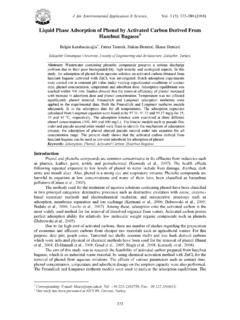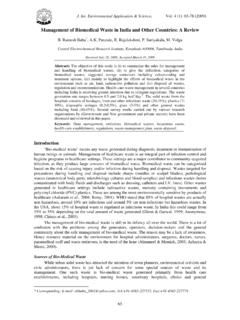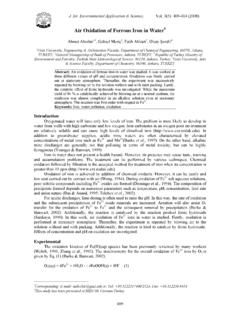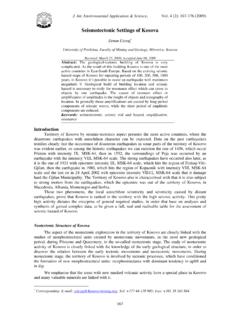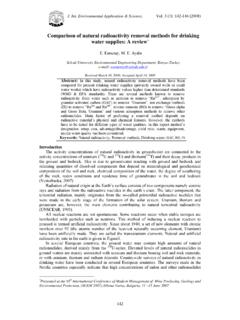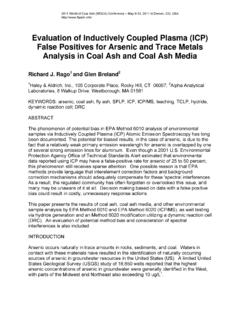Transcription of Determination of Cr(VI) in Enviro nmental Samples ...
1 J. Int. Environmental Application & Science, Vol. 4 (2): 207-213 (2009) 207 Determination of Cr(VI) in Environmental Samples Evaluating Cr(VI) Impact in a Contaminated Area Pranvera Lazo University of Tirana, Faculty of Natural Sciences, Department of Chemistry, Tirana, Albania Received April 15, 2009; Accepted June 10, 2009 Abstract: Spectrophotometric Determination of Cr+6 (using diphenyl carbazide), in aqueous, sediment and soil Samples is reported. Different leaching reagents like Na2CO3 and M H3PO4 were used for the isolation of Cr+6 from sediment and soil Samples . Determination of Cr6 by using Na2CO3 as leaching reagent followed by spectrophotometric measurements provided satisfied results.
2 The optimum experimental parameters of the reactions have been studied and the validity of the described procedures was assessed. Statistical analysis of the results has been carried out revealing high accuracy and good precision. Total Cr concentration was analyzed by AASF technique. This paper explores the development and application of Cr6 chemical speciation in a polluted area and marine environment. The polluted site of Porto Romano, Durres, pointed as Hot Spot Pollution from UNEP/MAP (1992) was under investigation. The content of Cr+6 in soil and surface water Samples inside territory of polluted site is very high (some g/kg in soil Samples and arrived up to 130 mg/l in surface water Samples ).
3 More than 90% of Crtot belongs to its easy s o l u b l e f o r m a n d o n l y 2 10% of it belongs to the form bounded with soils. The content of Cr+6 in seawater (about mg/l) and sediment (5-6 mg/kg as Crtot) Samples resulted within the normal levels. Only 11 to 13% of Crtot belongs to its easy s o l u b l e f o r m a n d m o s t o f i t (87 89%) belongs to the form bounded with sediments. Keywords: chromium, speciation, water, sediments and soils, UV-Vis spectrophotometry, AAS. Introduction: Chromium is a naturally occurring element present in water, sediments, rocks, soils, plants, biota, animals, and volcanic emissions.
4 It exists in a number of oxidation states, but only Cr3+ (non-toxic) and Cr6+ (toxic) are biologically and environmentally stable (Ducros, 1992). In solution state, Cr6+ may exist in three different ionic forms, such as hydro chromate (HCrO4-), chromate (CrO42-) and dichromate (Cr2O72-). It may also exist as water-soluble complex anions and may persist in water, whereas in surface water rich in organic contents, Cr6+ exhibits a much shorter lifetime (Callahan, et al., 1979). The presence of each ionic form of chromium in solution is pH dependent (EPA, 1984). Chromium is present as insoluble Cr2O3 H2O (Fishbein, 1981) in soils and only a small part of it may leached from soil.
5 Cr6+ in soil tends to be reduced to Cr3+ by organic matter. It is mostly derived from human activities (mostly from chromate chemicals ATSDR (1993), in the environment. Cr6+ is much more toxic than Cr3+, which is an essential nutrient required for normal energy metabolism and a dietary intake of 50-200 g Cr3+/day is recommended. The estimated exposure dose of Cr6+ is limited to mg/kg-day (Zhang and Li, 1987). Potassium dichromate has been reported as amplifier of some negative effects in organism (ATSDR, 1993, Susa, 1994). The bioavailability of chromium may be the single most important factor determining the toxicity of a specific chromium source (De Flora, 1987) and intracellular chromate reduction is required for chromium compounds to exert their genotoxic effects (ATSDR, 1993; O Flaherty, 1996).)
6 Due to the toxic behaviour of Cr6+, potassium dichromate polluted site of Porto Romano, Albania, pointed as Hot Spot Pollution from UNEP/MAP (1992), was the object of our study. Aiming to get a simple method for Cr6+ speciation, spectrophotometric Determination via diphenylcarbazide, in aqueous, sediment and soil Samples is validated whereas total Cr concentration was analyzed by AASF/and or AAS/ETA techniques. Corresponding: e-mail: Tel: ++355 684057734; Fax: ++355 4 2232083 J. Int. Environmental Application & Science, Vol. 4 (2): 207-213 (2009) 208 Materials and Methods Instruments A spectrophotometer type Shimadzu UV2401 PC was used for spectrophotometric Determination of Cr6+ in = 542 nm using glass cells 1 cm and/or 2 cm.
7 VARIAN 10+ atomic absorber is used for total Cr Determination ( = nm, = 0 . 2 n m , reducing C2H2/Air flame). Sampling area Durres, the main harbour of Albania, is a coastal city with more than 150,000 inhabitants located in the central-western part of the country. About km north of the city (in Porto Romano) a former chemical plant exists, extending on an overall surface of about 50 ha. It produced sodium dichromate, pesticides, such as Lindane (gamma-HCH), and other chemicals, until 1990. All production processes have been idle since the time and the plant s buildings have been totally destroyed. The area presents a hot spot , comprising the remains of the Lindane and dichromate factory, a dumpsite nearby and a chemical waste storage site.
8 Sampling sites The sampling stations (five soil Samples , S3 to S8, two seawater and sediment Samples , S1, S2 and W1, W2, three surface water Samples , W3 to W6) are shown in Figure 1. Figure 1. Sampling stations Sampling Procedure Sampling was implemented according to standard operation methods (APHA, 1998; ISO, 1999). Seawater/and or surface water Samples were conserved on PET bottles and after filtration through OSMONIC INC, glass filter ( micron) were acidified with 1ml/L HNO3 solution and stored at 5 C. Sediment Samples : The fractions smaller than 2 mm of the sediment Samples were well homogenized by grinding in agate mortar until all material was going through a 200 mesh nylon sieve.
9 The Samples for chemical analyses were stored in airtight plastic vials until required for future use. Soil Samples were collected up to 15 cm deep from the surface, were air dried, sieved through a mm screen, grounded and sieved through a mm screen. The homogenized Samples were stored in airtight pure plastic bags. Quality assurance of the data A reference certified material (SDM/2-TM) was analyzed at the same time with sediment Samples . Two inner standards (Cr6+ in seawater and soil Samples ) prepared in our laboratory, were analyzed at the same time with our Samples of studied area. It could be noticed the data obtained were in good agreement with certified values.
10 J. Int. Environmental Application & Science, Vol. 4 (2): 207-213 (2009) 209 Methods of chemical analysis Total Cr concentration was analyzed by AAS technique. It is a routine analysis in our laboratory, so we are focused on the extraction of Cr6+ from soils and sediment Samples , as well as in chemical method of its Determination . Aiming to get e simple method for Cr6+ speciation, spectrophotometric Determination of Cr+6 via diphenylcarbazide, in aqueous, sediment and soil Samples is optimized. Spectrophotometric Determination of Cr6+ The Determination of metal species in soil solutions, methods are used which generally are based on a more profound analytical background (APHA, 1985).
